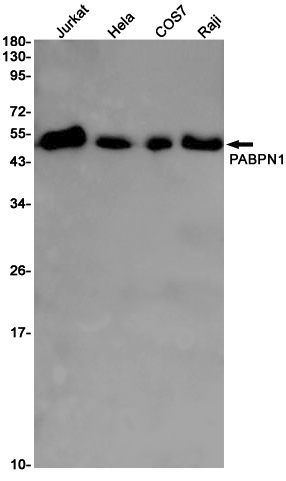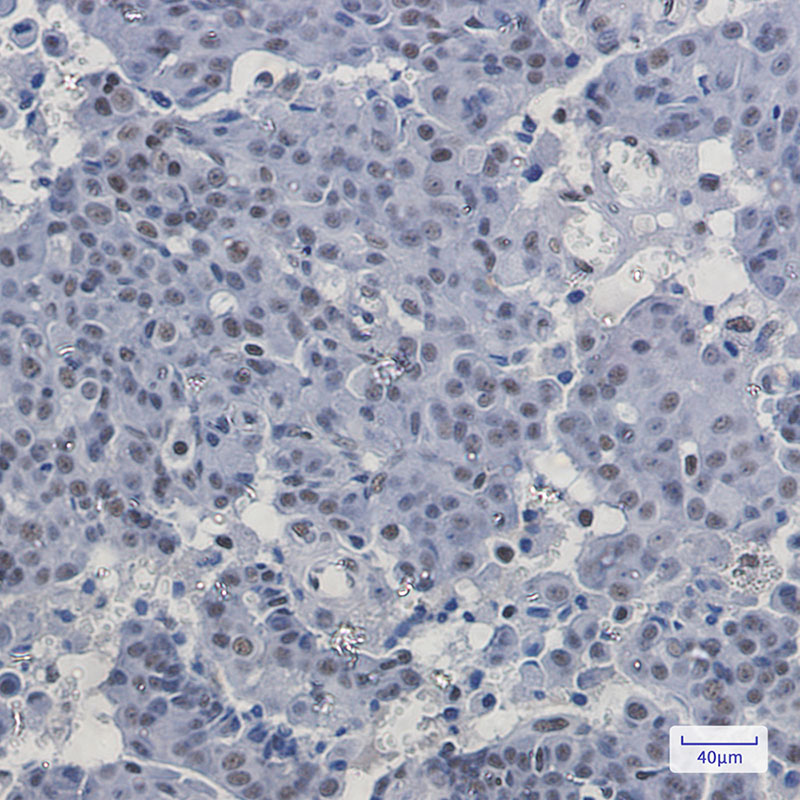

| WB | 1/500-1/1000 | Human,Mouse,Rat |
| IF | 1/20 | Human,Mouse,Rat |
| IHC | 1/50-1/100 | Human,Mouse,Rat |
| ICC | 1/50-1/200 | Human,Mouse,Rat |
| FCM | 咨询技术 | Human,Mouse,Rat |
| Elisa | 咨询技术 | Human,Mouse,Rat |
| Aliases | OPMD; PAB2; PABII; PABP2; PABP-2 |
| Entrez GeneID | 8106 |
| WB Predicted band size | Calculated MW: 33 kDa; Observed MW: 50 kDa |
| Host/Isotype | Rabbit IgG |
| Antibody Type | Primary antibody |
| Storage | Store at 4°C short term. Aliquot and store at -20°C long term. Avoid freeze/thaw cycles. |
| Species Reactivity | Human,Mouse |
| Immunogen | A synthetic peptide of human PABPN1 |
| Formulation | Purified antibody in TBS with 0.05% sodium azide,0.05%BSA and 50% glycerol. |
+ +
以下是关于PABPN1抗体的3篇参考文献示例(内容基于公开研究整理,具体文献需核实):
1. **文献名称**:*Nuclear inclusions in oculopharyngeal muscular dystrophy contain poly(A)-binding protein nuclear 1 (PABPN1)*
**作者**:Brais B, et al.
**摘要**:该研究利用PABPN1抗体发现OPMD患者肌肉细胞核内包涵体含有异常的PABPN1聚集,揭示了其与疾病中重复序列扩展突变的相关性。
2. **文献名称**:*PABPN1 functions as a scaffold for post-transcriptional RNA processing*
**作者**:Sachs R, et al.
**摘要**:通过免疫沉淀和抗体标记,研究揭示了PABPN1在mRNA多聚腺苷酸化和核质转运中的支架作用,并解析其与RNA聚合酶II的相互作用机制。
3. **文献名称**:*Altered phosphorylation and aggregation of PABPN1 in cellular models of neurodegeneration*
**作者**:Fan X, et al.
**摘要**:该研究使用PABPN1特异性抗体,发现神经退行性疾病模型中PABPN1的磷酸化异常促进其聚集,提示其在病理过程中的潜在作用。
如需具体文献,建议通过PubMed或Google Scholar以“PABPN1 antibody”及研究主题(如OPMD、RNA代谢)为关键词检索。
The polyadenylate-binding protein nuclear 1 (PABPN1) is a critical RNA-binding protein involved in mRNA polyadenylation and stability. It facilitates the addition of poly(A) tails to nascent mRNA transcripts by interacting with poly(A) polymerase and RNA, ensuring proper transcript processing and nuclear export. PABPN1 is ubiquitously expressed, with high concentrations in the nucleus, and contains an N-terminal acidic domain, an RNA recognition motif (RRM), and a C-terminal domain rich in alanine repeats. Mutations in the *PABPN1* gene, particularly the expansion of alanine repeats (from 10 to 12–17 alanines), are linked to oculopharyngeal muscular dystrophy (OPMD), a rare autosomal dominant disorder characterized by muscle weakness, dysphagia, and intranuclear aggregates in muscle cells.
Antibodies targeting PABPN1 are essential tools for studying its role in RNA metabolism, cellular stress responses, and disease mechanisms. They are widely used in techniques like Western blotting, immunofluorescence, and immunohistochemistry to detect endogenous PABPN1 levels, localization, and pathological aggregates in OPMD models. Due to its conserved structure and ubiquitous expression, generating specific antibodies requires careful validation to avoid cross-reactivity with other RNA-binding proteins. Commercial antibodies often target epitopes within the N-terminal or RRM regions. Studies using PABPN1 antibodies have elucidated its interactions with RNA-processing complexes and its aggregation propensity in neurodegenerative contexts. These tools also aid in diagnosing OPMD and screening therapeutic strategies aimed at reducing toxic nuclear inclusions.
×